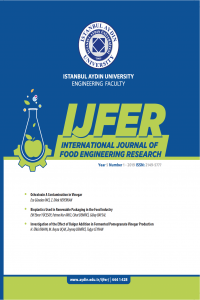INVESTIGATION OF THE EFFECTS OF LACTIC ACID BACTERIAL EXOPOLYSACCHARIDES ON THE RHEOLOGICAL PROPERTIES OF WHEAT BEVERAGE
INVESTIGATION OF THE EFFECTS OF LACTIC ACID BACTERIAL EXOPOLYSACCHARIDES ON THE RHEOLOGICAL PROPERTIES OF WHEAT BEVERAGE
Exopolysaccharides (EPS) which are produced by lactic acid bacterias are principally used in various fields such as the food industry, medicine, pharmacy, and cosmetics. Along with being colorless and odorless, bacterial EPSs have been subject to intensive research in recent years due to their various technological features and non-toxicity. In this study, changes in the rheological properties of wheat water of EPS, produced by eight different bacterial species and strains in soybean water were investigated. The species used in the study are Lactobacillus coryniformis C55, L. paracasei D41, L. Brevis 25A, Lactococcus lactis A47 and F39, Pediococcus parvulus E42, Streptococcus macedonicus A15 and Weisella confusa C19. In this study, the effect of EPS on the viscosity of wheat water was determined with the Ostwald-de Waele Model using Parallel Plate Sensor. At the same time, the pH of wheat water and distilled water was adjusted to 6.0 to eliminate the variables and viscosity behavior was examined at room temperature. Viscosity values appearing for 120 seconds at different shear rates from 0 s-1 to 300 s-1 were read in the study. The highest viscosity increase in wheat juice among the EPSs of the studied species was determined in the EPS produced by L. coryniformis C55 species. The findings obtained in the study showed that Lactobacillus coryniformis C55 has the potential to be used as a stabilizer in grain-borne foods.
Keywords:
Exopolysaacharides, , Reology, , Lactic Acid Bacteria, , Wheat , MRS,
___
- [1] Heperkan, D., Daşkaya-Dikmen, C. & Bayram, B. (2014). Evaluation of lactic acid bacterial strains of boza for their exopolysaccharide and enzyme production as a potential adjunct culture. Process Biochemistry, 10, 1587-1594.
- [2] Maalej, H., Boisset, C., Hmidet, N., Buon, L., Heyraud, A., & Nasri, M. (2014). Purification and structural data of a highly substituted exopolysaccharide from Pseudomonas stutzeri AS22. Carbohydrate Polymers, 112, 404–411.
- [3] Malik, A., Sheilla, S., Firdausi, W., Handayani, T., & Saepudin, E. (2015). Sucrase Activity and Exopolysaccharide Partial Characterization From Three Weissella confusa Strains. Journal of Biosciences, 22(3), 130–135.
- [4] Miao, M., Huang, C., Jia, X., Cui, S. W., Jiang, B., & Zhang, T. (2015). Physicochemical characteristics of a high molecular weight bioengineered α-D-glucan from Leuconostoc citreum SK24.002. Food Hydrocolloids, 50, 37–43.
- [5] Gorska-Fraczek, S., Sandström C, Kenne L, Paściak M, Brzozowska E, Strus M, Heczko P. & Gamian A. (2013). The structure and immunoreactivity of exopolysaccharide isolated from Lactobacillus johnsonii strain 151. Carbohydrate Research, 378, 148-153.
- [6] Russo, P., de Chiara, M. L. V., Capozzi, V., Arena, M. P., Amodio, M. L., Rascón, A., Dueñas, M. T., López, P., & Spano, G. (2016). Lactobacillus plantarum strains for multifunctional oat-based foods. LWT- Food Science and Technology, 68, 288–294.
- [7] Martin, R., Olivares, M., Marín, M. L., Xaus, J., Fernández, L., & Rodríguez, J. M. (2005). Characterization of a reuterin-producing Lactobacillus coryniformis strain isolated from a goat’s milk cheese. International Journal of Food Microbiology, 104(3), 267–277.
- [8] Slavica, A., Trontel, A., Jelovac, N., Kosovec, Ž., Šantek, B., & Novak, S. (2015). Production of lactate and acetate by Lactobacillus coryniformis subsp. torquens DSM 20004 T in comparison with Lactobacillus amylovorus DSM 20531 T. Journal of Biotechnology, 202, 50–59.
- [9] Yi, L. Dang, J., Zhang, L., Wu, Y., Liu, B. & Lü, X. (2016). Purification, characterization and bactericidal mechanism of a broad spectrum bacteriocin with antimicrobial activity against multidrug-resistant strains produced by Lactobacillus coryniformis XN8. Food Control, 67, 53-62.
- [10] Lavermicocca, P., Dekker, M., Russo, F., Valerio, F., Di Venere, D., & Sisto, A. (2016). Lactobacillus paracasei- Enriched Vegetables Containing Health Promoting Molecules. In Probiotics, Prebiotics, and Synbiotics, 4, 361–370.
- [11] Gobbetti, M. & Minervini, F. (2014). Lactobacillus: Lactobacillus casei. Encyclopedia of Food Microbiology, 2, 432-438.
- [12] Demarigny, Y. (2014). Lactococcus: Lactococcus lactis subspecies lactis and cremoris. Encyclopedia of Food Microbiology, 2, 442-446.
- [13] Mills, S., Ross, R.P. & Coffey, A. (2011). Lactic acid bacteria: Lactococcus lactis. Encyclopedia of Dairy Sciences, 2, 132-137.
- [14] Holland, R., Crow, V., & Curry, B. (2011). Lactic Acid Bacteria| Pediococcus spp. In: Encyclopedia of Dairy Sciences, 2, 149-152.
- [15] Raccach, M. (2014). Pediococcus. Encyclopedia of Food Microbiology, 2, 1-5
- [16] Gobbetti, M. & Calasso, M. (2014). Streptococcus| Introduction. Encyclopedia of Food Microbiology, 2, 535-553.
- [17] Cagno Di, R. & Coda, R. (2014). Fermented foods | Fermented Vegetable Products. Encyclopedia of Food Microbiology, 2, 875-883
- [18] Pérez-Ramos, A., Nácher-Vázquez, M., Notararigo, S., López, P., & Mohedano, M. L. (2015). Current and future applications of bacterial extracellular polysaccharides. Probiotics, Prebiotics, and Synbiotics. Eds. Preedy, VR, Watson, RR ISBN: 9780128021897.
- [19] Shi, Q., Juvonen, M., Hou, Y., Kajala, I., Nyyssölä, A., Maina, N. H., Maaheimo, H., Virkki, L. & Tenkanen, M. (2016). Lactose- and cellobiosederived branched trisaccharides and a sucrosecontaining trisaccharide produced by acceptor reactions of Weissella confusa dextransucrase. Food Chemistry, 190, 226–236.
- [20] Calasso, M. & Gobbetti, M. (2011). Lactobacillus spp.: Other Species. Encyclopedia of Dairy Sciences, 2, 125-131. doi:10.1016/B978-0- 12-374407- 4.00265-X.
- [21] Suzuki, K. (2015). Gram-positive spoilage bacteria in brewing. Brewing Microbiology, 141- 173.
- [22] Raposo, M., Morais, A. & Morais, R. (2014). Influence of sulphate on the composition and antibacterial and antiviral properties of the exopolysaccharide from Porphyridium cruentum. Life Sciences, 101, 56-63.
- [23] Hidalgo-Cantabrana, C., Nikolic M, López P, Suárez A, Miljkovic M, Kojic M, Margolles A, Golic N. & Ruas-Madiedo P. (2014). Exopolysaccharide-producing Bifidobacterium animalis subsp. lactis strains and their polymers elicit different responses on immune cells from blood and gut associated lymphoid tissue. Anaerobe, 26, 24-30.
- ISSN: 2149-5777
- Başlangıç: 2015
- Yayıncı: İstanbul Aydın Üniversitesi
